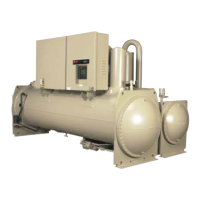52 RTHD-SVX01D-EN
Installation Mechanical
Flow switches must stop or prevent compressor operation if either system
water flow drops off below the required minimum shown on the pressure
drop curves. Follow the manufacturer’s recommendations for selection and
installation procedures. General guidelines for flow switch installation are out-
lined below.
• Mount the switch upright, with a minimum of 5 pipe diameters straight,
horizontal run on each side.
• Do not install close to elbows, orifices or valves.
NOTE: The arrow on the switch must point in the direction of the water
flow.
• To prevent switch fluttering, remove all air from the water system
NOTE: The CH530 provides a 6-second time delay on the flow switch input
before shutting down the unit on a loss-of-flow diagnostic. Contact a qualified
service organization if nuisance machine shutdowns persist.
• Adjust the switch to open when water flow falls below nominal. Refer to
the General Data table in Section 1 for minimum flow recommendations
for specific water pass arrangements. Flow switch contacts are closed on
proof of water flow.
Refrigerant Pressure Relief Valve Venting
WARNING
Hazardous Gases!
Consult local regulations for any special relief line requirements.
Refrigerant vented into a confined equipment room could
displace available oxygen to breathe, causing possible
asphyxiation or other serious health risks. Failure to follow these
recommendations could result in death or serious injury.
NOTE: Vent pipe size must conform to the ANSI/ASHRAE Standard 15 for
vent pipe sizing. All federal, state, and local codes take precedence over any
suggestions stated in this manual.
All relief valve venting is the responsibility of the installing contractor.
All RTHD units use evaporator, compressor, and condenser pressure relief
valves (Figure 16) that must be vented to the outside of the building.
Relief valve connection sizes and locations are shown in the unit submittals.
Refer to local codes for relief valve vent line sizing information.
Caution
Equipment Damage!
Do not exceed vent piping code specifications. Failure to comply
with specifications may result in capacity reduction, unit damage
and/or relief valve damage.

